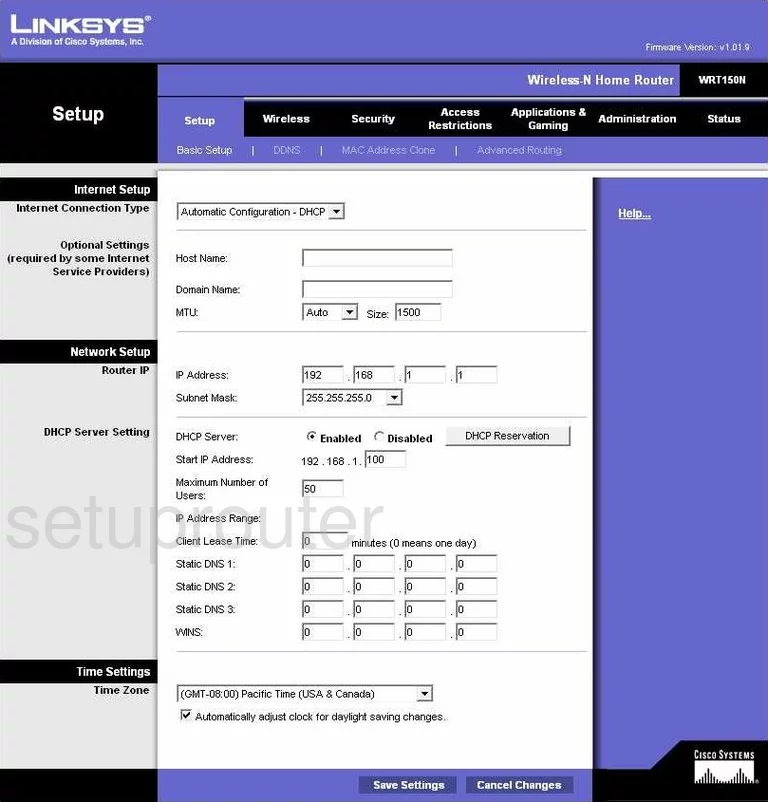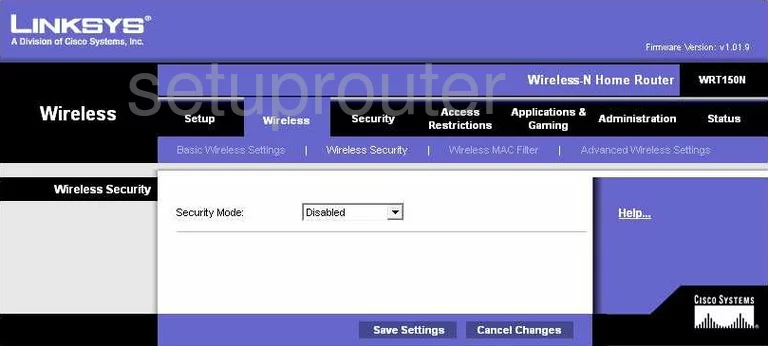The Linksys WRT150N router is considered a wireless router because it offers WiFi connectivity. WiFi, or simply wireless, allows you to connect various devices to your router, such as wireless printers, smart televisions, and WiFi enabled smartphones.
Other Linksys WRT150N Guides
This is the wifi guide for the Linksys WRT150N. We also have the following guides for the same router:
- Linksys WRT150N - How to change the IP Address on a Linksys WRT150N router
- Linksys WRT150N - Linksys WRT150N User Manual
- Linksys WRT150N - Linksys WRT150N Login Instructions
- Linksys WRT150N - How to change the DNS settings on a Linksys WRT150N router
- Linksys WRT150N - How to Reset the Linksys WRT150N
- Linksys WRT150N - Information About the Linksys WRT150N Router
- Linksys WRT150N - Linksys WRT150N Screenshots
WiFi Terms
Before we get started there is a little bit of background info that you should be familiar with.
Wireless Name
Your wireless network needs to have a name to uniquely identify it from other wireless networks. If you are not sure what this means we have a guide explaining what a wireless name is that you can read for more information.
Wireless Password
An important part of securing your wireless network is choosing a strong password.
Wireless Channel
Picking a WiFi channel is not always a simple task. Be sure to read about WiFi channels before making the choice.
Encryption
You should almost definitely pick WPA2 for your networks encryption. If you are unsure, be sure to read our WEP vs WPA guide first.
Login To The Linksys WRT150N
To get started configuring the Linksys WRT150N WiFi settings you need to login to your router. If you are already logged in you can skip this step.
To login to the Linksys WRT150N, follow our Linksys WRT150N Login Guide.
Find the WiFi Settings on the Linksys WRT150N
If you followed our login guide above then you should see this screen.

Begin on the Basic Setup page of the Linksys WRT150N. To configure the wireless settings, click the option at the top of the page labeled Wireless. Below that choose the option of Basic Wireless Settings.
Change the WiFi Settings on the Linksys WRT150N

This directs to a page like the one you see above. First use the Network Mode to choose what type of wireless devices you are connecting to your network. Wireless-B indicates the oldest, pre-2003. Wireless-G indicates pre-2009. Wireless-N indicates to the present. If you are unsure, choose the option of Mixed.
Next is the Network Name (SSID). This is the name you create in order to identify your network. This name can be anything you like but it is recommended that you avoid personal information for your security. Learn more in our Wireless Name Guide.
We recommend setting the Radio Band to Auto.
Using the Wide Channel drop down menu, choose channel 6. Then, from the Standard Channel list, choose 1 or 11. If you are interested in learning why you should always use these three channels, read our WiFi Channels Guide.
That's all that needs to be done on this page, just click the Save Settings button in the blue bar at the bottom of the page.
Then, looking back to the top of the page, click Wireless Security.

You are now taken to a page that looks similar to the one you see above. Use the first drop down list titled Security Mode to choose the option of PSK2 Personal. This is also referred to as WPA2-PSK. This is the most secure option available to home networks. Learn why in our WEP vs. WPA guide.
The second setting is titled Encryption. We recommend setting this to AES.
Lastly, change the Pre-Shared Key. This is the password you use to gain access to your network. It is very important that you change this password from the default. Hackers know the router defaults and try those passwords first. Create a strong password that will discourage hackers from attacking you. Make you password a minimum of 14-20 characters. Use a mix of symbols, numbers, and letters. Learn more in our Choosing a Strong Password Guide.
Once you are done here, apply your changes by clicking the option at the bottom of the page labeled Save Settings.
Possible Problems when Changing your WiFi Settings
After making these changes to your router you will almost definitely have to reconnect any previously connected devices. This is usually done at the device itself and not at your computer.
Other Linksys WRT150N Info
Don't forget about our other Linksys WRT150N info that you might be interested in.
This is the wifi guide for the Linksys WRT150N. We also have the following guides for the same router:
- Linksys WRT150N - How to change the IP Address on a Linksys WRT150N router
- Linksys WRT150N - Linksys WRT150N User Manual
- Linksys WRT150N - Linksys WRT150N Login Instructions
- Linksys WRT150N - How to change the DNS settings on a Linksys WRT150N router
- Linksys WRT150N - How to Reset the Linksys WRT150N
- Linksys WRT150N - Information About the Linksys WRT150N Router
- Linksys WRT150N - Linksys WRT150N Screenshots